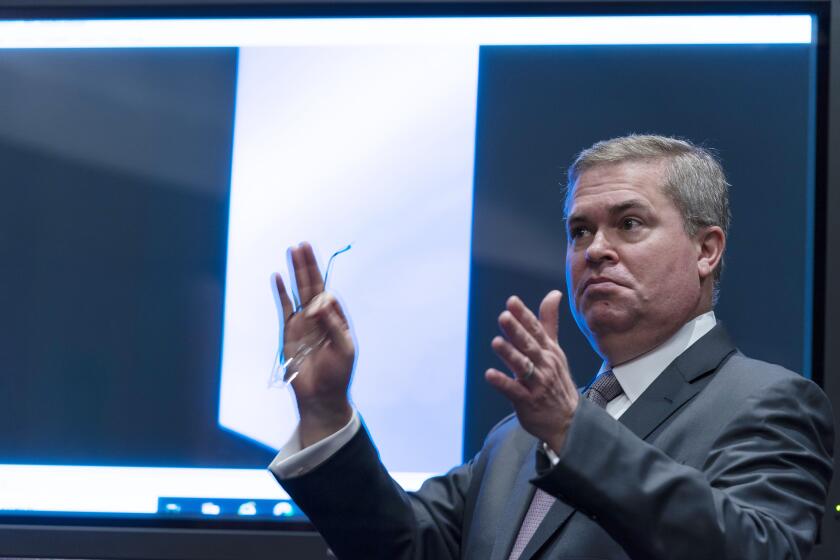Opinion: UFOs and aliens had their day in Congress. Was it illuminating?

- Share via
Wednesday’s hearing from a congressional subcommittee probing unidentified anomalous phenomena, or UAP, introduced a new chapter in an ongoing saga.
For almost six years now, newspapers, cable news and social media have regaled us with stories about military encounters with strange aircraft and secret government UFO programs. The fallout has led to the creation of a new government office to track UAP sightings (the All-domain Anomaly Resolution Office or AARO) and an independent study panel to advise NASA on the phenomenon. Even the National Archives and Records Administration has been digitizing government records on unidentified flying objects over the past few months.
The hearing, held by the House Subcommittee on National Security, the Border and Foreign Affairs, gave speaking time to three witnesses: former Navy pilots David Fravor and Ryan Graves and former intelligence official David Grusch. All three had already spoken to the media about their experiences, but this was public testimony under oath.
Grusch’s allegations were by far the most explosive, claiming that the government had access to crashed “nonhuman” technology with “biologics” aboard and that the artifacts were being reverse engineered. Grusch admitted, however, “I’m speaking to the facts as I’ve been told them.” Afterward, Rep. Tim Burchett (R-Tenn.) congratulated the three men and announced, “We made history today.”
Not everyone is convinced aliens are involved. ‘If we had found a UFO, I think the Department of Defense would tell us,’ House Speaker Kevin McCarthy said.
Just how historic the hearing was is up for debate. Yes, it was novel to have Congress hear openly from some UFO witnesses who appear sincere and credible. But there wasn’t much new information shared, and Grusch balked when he was asked to give details about his most stunning claims in an open forum. If the Twitterverse (X-verse?) is a reliable guide, both UFO believers and skeptics came away unshaken in their views — showing the limits of pushing to shine a light on this issue.
Discussion about UFOs has always been about more than just the prospect of alien visitors, and this time was no different. From the outset, both Republicans and Democrats invoked one word to highlight what the hearing was all about: transparency. Representatives insisted on greater transparency from the military, from the intelligence community and from private defense contractors.
The demand for greater government openness about UFOs has a long history, dating back to the very first wave of “flying saucer” sightings in 1947. But while many have beaten the drum for transparency — inspiring what’s been called the disclosure movement by a largely online community — this goal has been stubbornly elusive.
There are a number of reasons for this.
For one thing, both military and intelligence officials in the U.S., South America and Europe have historically downplayed UFO sightings while also keeping a good deal of information about them classified. While the classification is not exactly surprising from government agencies, some observers have seen in this an indication of what Burchett called a “cover-up.”
As far back as the 1960s, however, others like atmospheric physicist James McDonald believed government’s blasé attitude toward UFOs stemmed from incompetence and ignorance. He and astronomer J. Allen Hynek were of the view that the only solution lay in having civilian scientists take the lead in examining the phenomenon, comparable to the panel of civilian scientists recently appointed to advise NASA.
The government has renewed interest in UFOs. Scientists can show what it looks like to investigate the possibility of alien life rationally.
Another factor complicating the pursuit of transparency is politics. Secrecy has been an indelible part of all modern states and became only more pronounced during World War II and the Cold War (just watch “Oppenheimer”). While those demanding disclosure often claim to be scrutinizing the deficiencies of government at large, the targets tend to be the policies of specific administrations.
The hearing Wednesday provided an example of this very thing. While lip service was paid to nonpartisanship, both Rep. Glenn Grothman (R-Wis.) and Rep. Virginia Foxx (R-N.C.) used the occasion to castigate the Biden administration for its handling of the Chinese balloon incident back in February, with Foxx dubbing it a “fiasco.” The call for openness is sometimes just partisan politics by other means.
Finally, transparency doesn’t guarantee clarity and consensus, especially not on a topic as consequential as whether UFOs and aliens are real.
In 1994, the Office of the Secretary of the Air Force released the results of its investigation into the famous Roswell Incident of 1947, concluding witnesses had been mistaken about the existence of flying saucer crash and alien body retrievals in New Mexico. Files from the Air Force’s old UFO investigation, Project Blue Book, have long been publicly available.
In fact, across the globe countries including Australia, Brazil, Canada, Denmark, Italy, New Zealand and Spain have released thousands of pages of declassified UFO-related documents. Between 2008 and 2013, the U.K. released around 60,000 pages of its Ministry of Defense’s UFO reports and correspondence.
Yet despite this, UFO enthusiasts and researchers have not always agreed on how to interpret the released documents and have continued to accuse officials of holding back key records.
Without a doubt, the hearing has left advocates of disclosure emboldened to carry on the cause. Yet it remains to be seen just how illuminating transparency will ever be.
Greg Eghigian is a professor of history and bioethics at Penn State University and the author of “After the Flying Saucers Came: A Global History of the UFO Phenomenon,” forthcoming in 2024.
More to Read
A cure for the common opinion
Get thought-provoking perspectives with our weekly newsletter.
You may occasionally receive promotional content from the Los Angeles Times.











